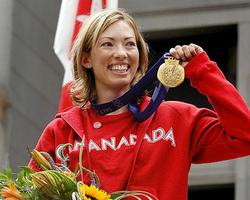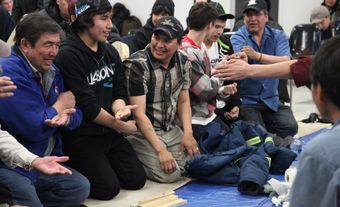Origins
Though cross-country skiing originated in Scandinavia over 5000 years ago, it was not introduced to Canada until the 1890s. In the early stages of the sport, most skiers carried a single pole and wore long (2.5 to 4 m), wide (over 80 mm), unlaminated wooden skis that were so heavy (several kg each) and awkwardly fastened that skiers usually removed them and carried them up steep hills. In 1915 the Norwegian Thorleif Haug invented screw-on steel toe-plates that eliminated the need to carve slots through the middle of the skis to hold toe-straps. This made skis much stronger and permitted the adoption of shorter (under 2.5 m), narrower (less than 60 mm) and lighter (under 1 kg each) skis. Used with a pair of bamboo poles, such skis remained the standard for all forms of skiing for the next 20 years.
Recreation
Cross-country skiing began to take on a more recreational form when, in 1927, the CPR introduced Laurentian ski trains. This led to the wide use of an extensive trail network blazed by avid skiers like "Jackrabbit" Johannsen. By 1935 similar developments were to be found all across North America, where skiers enthusiastically adopted the use of ski lifts, from the rope tow, invented in Shawbridge, Québec, in 1932, to the chairlift, introduced into Canada at Mont Tremblant in 1938. Skis were quickly adapted for use on large hills through the introduction of steel edges for stability on ice (about 1930) and cable bindings that held the heels down for greater control. Within a decade, cross-country skiing became a sport requiring special equipment and practised by only a small core of devotees.
In 1967 several hundred cross-country skiers celebrated the Centennial year by skiing 160 km from Montréal to Ottawa. Their 3-day expedition has since evolved into the Canadian Ski Marathon, the longest ski event in North America. The CSM has become a 2-day tour annually, attracting over 2000 skiers from Canada, the US and as many as 10 foreign countries. The course runs from Lachute, Québec, through the forests and farms of the Outaouais region to finish in the National Capital Region (Ottawa/Hull) at the climax of the Winterlude festival in mid-February. Its many categories cater to skiers of all ages and abilities, from 4-year-olds skiing 16 km a day to Gold Coureur de Bois carrying 10-kg packs over the entire distance and camping out overnight.
During the 1970s people caught up in the fitness boom or rebelling against the expense and congestion of alpine skiing took up cross-country in even greater numbers. The Canadian Ski Marathon, for example, grew from 400 to over 4000 participants during that decade, and scores of other tours and races for the general public sprang up across the country.
A significant trend in Canadian skiing has been the tremendous growth in the sport on a recreational level. Over 3.5 million Canadians own cross-country equipment, of whom almost 2 million ski once a week or more during the winter months. After 50 years of increasing specialization of equipment and technique, a strong movement is afoot today to return to all-purpose touring skis and flexible leather boots and bindings that leave the heels free. Using such equipment and the Telemark turning technique of the early 1900s, skiers are again able to enjoy both the challenge and exhilaration of downhill skiing and the healthy exercise and serenity of cross-country skiing.
Competition
Although Canadian national cross-country championships have been held since 1921, it is only within the last few years that increased interest in the sport produced internationally competitive athletes - such as Sharon and Shirley Firth, Pierre Harvey, Beckie Scott and Chandra Crawford - who could keep up with the dominant European skiers. The Nordic combined event - cross-country skiing and ski jumping - has been held internationally and at the Olympics since 1924 but Canada has yet to perform well internationally.
During the 1980s and 1990s technological innovation changed the sport. Simple waxing systems and no-wax skis reduced the complexity of ski preparation. Synthetic materials allowed the manufacture of extremely light, strong skis and poles. New boot-binding systems improved control at high speeds. Since the new skis glide much faster, skating and double-poling techniques have assumed increasing dominance in international competition. In the mid-1980s, in fact, a separate "classical" racing category was created to preserve the traditional techniques apart from the faster "freestyle" skating. The skating technique is also popular with recreational skiers using prepared trails, since it is relatively simple to learn and requires no gripping waxes, only gliders. Although technology has simplified the sport on the recreational side, it has increased the complexity for elite racing. The choice of equipment and the process of ski waxing is now an acquired "art" involving a wide array of glide and grip waxes for all snow conditions.
At the 2002 Salt Lake Olympics, Beckie Scott won North America's first medal in cross-country skiing, finishing behind Russian teammates Olga Danilova and Larissa Lazutina in the 5 km sprint. When both Danilova and Lazutina tested positive for drugs in other races, the Canadian Olympic Committee (COC) put forth an appeal with the International Olympic Committee that the Russian skiers should also lose their 5 km medals. The COC cited the Olympic Charter that says any athlete caught cheating at the Olympics should be stripped of all medals won at that Olympics. In June 2003 Scott was awarded the silver medal that had previously been awarded to Lazutina. In December of that year she was awarded the gold that had been Danilova's. In addition to winning North America's first cross-country medal, Scott now holds the distinction of being the only person ever to be awarded the gold, silver and bronze medals for the same event.
Canadian cross-country athletes attended the 2006 Olympic Games at Torino and produced medal-winning performances. Chandra Crawford won the gold medal in the women's 1.5 km sprint event. Against all odds, Canadians Sara Renner and Beckie Scott won the silver medal in the women's team sprint event. One of Renner's poles broke during the race, and with true Olympic spirit the Norwegian team's coach lent Renner a spare pole to complete the race.

 Share on Facebook
Share on Facebook Share on X
Share on X Share by Email
Share by Email Share on Google Classroom
Share on Google Classroom







